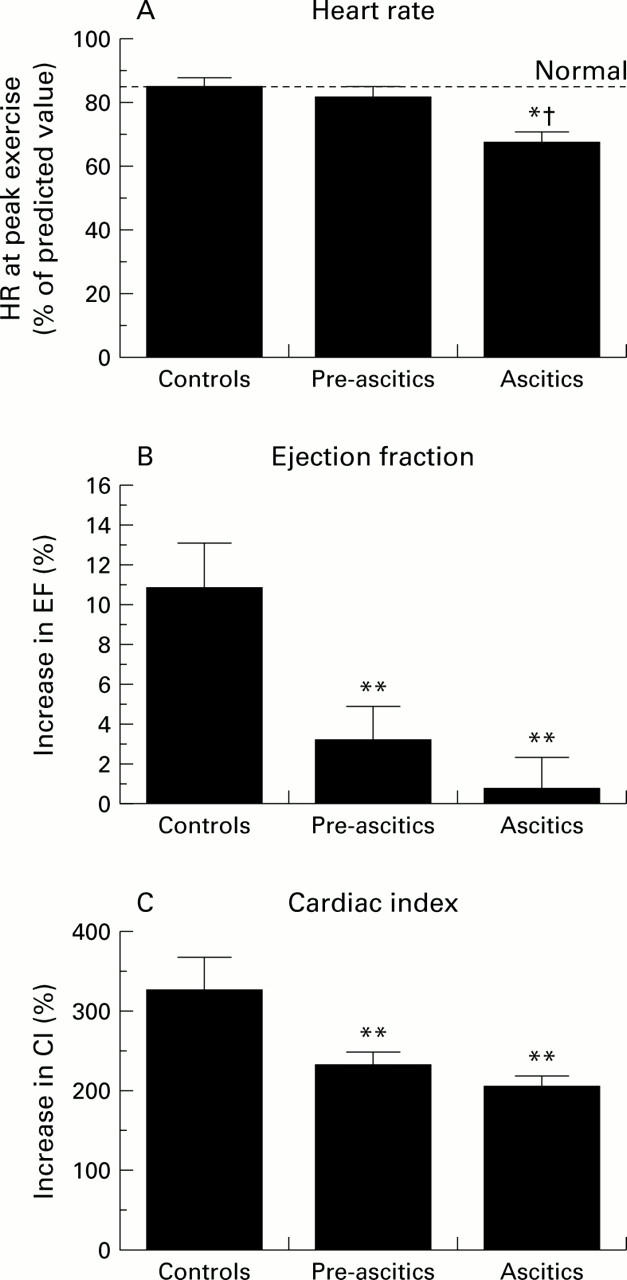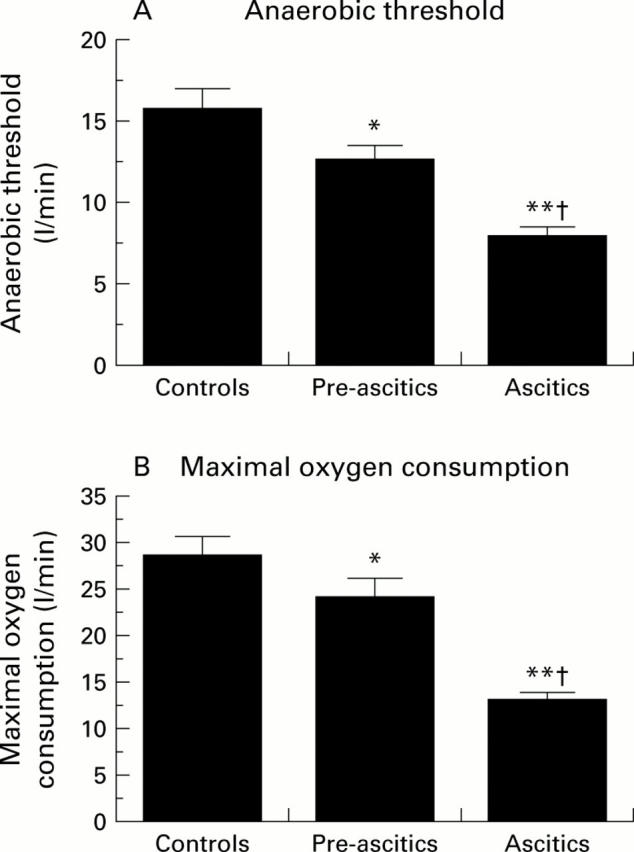Abstract
BACKGROUND—Impaired exercise capacity and oxygen consumption are common in cirrhosis. AIM—To explore the relationship between possible myocardial dysfunction and exercise tolerance in cirrhosis. METHODS—Cardiac responses to exercise, using radionuclide angiography and graded upright cycle ergometry with oxygen consumption, were assessed before and after exercise in 39 cirrhotics patients and compared with 12 age and sex matched healthy volunteers. Baseline cardiac chamber dimensions and wall thickness, ejection fraction, and diastolic function were measured using two dimensional echocardiography is all subjects. RESULTS—Baseline diastolic dysfunction with prolonged isovolumic relaxation times (p=0.02), left atrial enlargement, and left ventricular wall thickening were present in all cirrhotics (p=0.02), despite increased mean ejection fraction. With graded exercise, cirrhotics achieved 71 (4)% (p=0.03) (pre-ascitics) and 46 (3)% (p<0.001) (ascitics) of predicted work loads, respectively, without significant increases in ejection fraction. The smaller absolute and percentage increases in cardiac output (p=0.003) in the cirrhotics were associated with significantly reduced oxygen consumption (p=0.003) and anaerobic threshold (p<0.001), and correlated significantly with work and metabolic parameters. CONCLUSIONS—Impaired exercise capacity in cirrhosis is associated with myocardial thickening and ventricular stiffness leading to decreased diastolic function, inotropic and chronotropic incompetence under conditions of stress, with metabolic consequences. This picture is compatible with the condition now known as cirrhotic cardiomyopathy. Keywords: cirrhosis; exercise tolerance; myocardial function; oxygen consumption
Full Text
The Full Text of this article is available as a PDF (159.3 KB).
Figure 1 .

Increase in (A) heart rate (HR), (B) ejection fraction (EF), and (C) cardiac index (CI) with peak exercise in healthy controls, pre-ascitic, and ascitic cirrhotic patients. HR is expressed as a percentage of predicted values. Values are mean (SEM). *p<0.05, **p<0.01 compared with controls; †p<0.05 pre-ascitics compared with ascitic cirrhotic patients.
Figure 2 .

(A) Anaerobic threshold and (B) oxygen consumption with exercise in healthy controls, pre-ascitic, and ascitic cirrhotic patients. Values are mean (SEM). *p<0.05, **p<0.01 compared with controls; †p<0.05 pre-ascitics compared with ascitic cirrhotic patients.
Selected References
These references are in PubMed. This may not be the complete list of references from this article.
- Agusti A. G., Roca J., Rodriguez-Roisin R., Mastai R., Wagner P. D., Bosch J. Pulmonary hemodynamics and gas exchange during exercise in liver cirrhosis. Am Rev Respir Dis. 1989 Feb;139(2):485–491. doi: 10.1164/ajrccm/139.2.485. [DOI] [PubMed] [Google Scholar]
- Agusti A. G., Roca J., Rodriguez-Roisin R. Mechanisms of gas exchange impairment in patients with liver cirrhosis. Clin Chest Med. 1996 Mar;17(1):49–66. doi: 10.1016/s0272-5231(05)70298-7. [DOI] [PubMed] [Google Scholar]
- Balligand J. L. Regulation of cardiac beta-adrenergic response by nitric oxide. Cardiovasc Res. 1999 Aug 15;43(3):607–620. doi: 10.1016/s0008-6363(99)00163-7. [DOI] [PubMed] [Google Scholar]
- Bernardi M., Rubboli A., Trevisani F., Cancellieri C., Ligabue A., Baraldini M., Gasbarrini G. Reduced cardiovascular responsiveness to exercise-induced sympathoadrenergic stimulation in patients with cirrhosis. J Hepatol. 1991 Mar;12(2):207–216. doi: 10.1016/0168-8278(91)90940-d. [DOI] [PubMed] [Google Scholar]
- Bomzon A., Blendis L. M. The nitric oxide hypothesis and the hyperdynamic circulation in cirrhosis. Hepatology. 1994 Nov;20(5):1343–1350. [PubMed] [Google Scholar]
- Campillo B., Fouet P., Bonnet J. C., Atlan G. Submaximal oxygen consumption in liver cirrhosis. Evidence of severe functional aerobic impairment. J Hepatol. 1990 Mar;10(2):163–167. doi: 10.1016/0168-8278(90)90046-t. [DOI] [PubMed] [Google Scholar]
- Castaing Y., Manier G. Hemodynamic disturbances and VA/Q matching in hypoxemic cirrhotic patients. Chest. 1989 Nov;96(5):1064–1069. doi: 10.1378/chest.96.5.1064. [DOI] [PubMed] [Google Scholar]
- Finucci G., Desideri A., Sacerdoti D., Bolognesi M., Merkel C., Angeli P., Gatta A. Left ventricular diastolic function in liver cirrhosis. Scand J Gastroenterol. 1996 Mar;31(3):279–284. doi: 10.3109/00365529609004879. [DOI] [PubMed] [Google Scholar]
- Franco D., Vons C., Traynor O., de Smadja C. Should portosystemic shunt be reconsidered in the treatment of intractable ascites in cirrhosis? Arch Surg. 1988 Aug;123(8):987–991. doi: 10.1001/archsurg.1988.01400320073015. [DOI] [PubMed] [Google Scholar]
- Goodman J. M., McLaughlin P. R., Plyley M. J., Holloway R. M., Fell D., Logan A. G., Liu P. P. Impaired cardiopulmonary response to exercise in moderate hypertension. Can J Cardiol. 1992 May;8(4):363–371. [PubMed] [Google Scholar]
- Gray M. O., Long C. S., Kalinyak J. E., Li H. T., Karliner J. S. Angiotensin II stimulates cardiac myocyte hypertrophy via paracrine release of TGF-beta 1 and endothelin-1 from fibroblasts. Cardiovasc Res. 1998 Nov;40(2):352–363. doi: 10.1016/s0008-6363(98)00121-7. [DOI] [PubMed] [Google Scholar]
- Green D. J., O'Driscoll G., Blanksby B. A., Taylor R. R. Control of skeletal muscle blood flow during dynamic exercise: contribution of endothelium-derived nitric oxide. Sports Med. 1996 Feb;21(2):119–146. doi: 10.2165/00007256-199621020-00004. [DOI] [PubMed] [Google Scholar]
- Grose R. D., Nolan J., Dillon J. F., Errington M., Hannan W. J., Bouchier I. A., Hayes P. C. Exercise-induced left ventricular dysfunction in alcoholic and non-alcoholic cirrhosis. J Hepatol. 1995 Mar;22(3):326–332. doi: 10.1016/0168-8278(95)80286-x. [DOI] [PubMed] [Google Scholar]
- Guillo P., Mansourati J., Maheu B., Etienne Y., Provost K., Simon O., Blanc J. J. Long-term prognosis in patients with alcoholic cardiomyopathy and severe heart failure after total abstinence. Am J Cardiol. 1997 May 1;79(9):1276–1278. doi: 10.1016/s0002-9149(97)00101-x. [DOI] [PubMed] [Google Scholar]
- HALL E. M., OLSEN A. Y., DAVIS F. E. Portal cirrhosis; clinical and pathologic review of 782 cases from 16,600 necropsies. Am J Pathol. 1953 Nov-Dec;29(6):993–1027. [PMC free article] [PubMed] [Google Scholar]
- Hickner R. C., Fisher J. S., Ehsani A. A., Kohrt W. M. Role of nitric oxide in skeletal muscle blood flow at rest and during dynamic exercise in humans. Am J Physiol. 1997 Jul;273(1 Pt 2):H405–H410. doi: 10.1152/ajpheart.1997.273.1.H405. [DOI] [PubMed] [Google Scholar]
- Kadambi V. J., Ponniah S., Harrer J. M., Hoit B. D., Dorn G. W., 2nd, Walsh R. A., Kranias E. G. Cardiac-specific overexpression of phospholamban alters calcium kinetics and resultant cardiomyocyte mechanics in transgenic mice. J Clin Invest. 1996 Jan 15;97(2):533–539. doi: 10.1172/JCI118446. [DOI] [PMC free article] [PubMed] [Google Scholar]
- Kaye D. M., Kelly R. A., Smith T. W. Cytokines and cardiac hypertrophy: roles of angiotensin II and basic fibroblast growth factor. Clin Exp Pharmacol Physiol Suppl. 1996;3:S136–S141. [PubMed] [Google Scholar]
- LUNSETH J. H., OLMSTEAD E. G., ABBOUD F. A study of heart disease in one hundred eight hospitalized patients dying with portal cirrhosis. AMA Arch Intern Med. 1958 Sep;102(3):405–413. doi: 10.1001/archinte.1958.00030010405009. [DOI] [PubMed] [Google Scholar]
- Laffi G., Barletta G., La Villa G., Del Bene R., Riccardi D., Ticali P., Melani L., Fantini F., Gentilini P. Altered cardiovascular responsiveness to active tilting in nonalcoholic cirrhosis. Gastroenterology. 1997 Sep;113(3):891–898. doi: 10.1016/s0016-5085(97)70184-7. [DOI] [PubMed] [Google Scholar]
- Lee S. S., Marty J., Mantz J., Samain E., Braillon A., Lebrec D. Desensitization of myocardial beta-adrenergic receptors in cirrhotic rats. Hepatology. 1990 Sep;12(3 Pt 1):481–485. doi: 10.1002/hep.1840120306. [DOI] [PubMed] [Google Scholar]
- Lindpaintner K., Lund D. D., Schmid P. G. Effects of chronic progressive myocardial hypertrophy on indexes of cardiac autonomic innervation. Circ Res. 1987 Jul;61(1):55–62. doi: 10.1161/01.res.61.1.55. [DOI] [PubMed] [Google Scholar]
- Links J. M., Becker L. C., Shindledecker J. G., Guzman P., Burow R. D., Nickoloff E. L., Alderson P. O., Wagner H. N. Measurement of absolute left ventricular volume from gated blood pool studies. Circulation. 1982 Jan;65(1):82–91. doi: 10.1161/01.cir.65.1.82. [DOI] [PubMed] [Google Scholar]
- Ma Z., Lee S. S., Meddings J. B. Effects of altered cardiac membrane fluidity on beta-adrenergic receptor signalling in rats with cirrhotic cardiomyopathy. J Hepatol. 1997 Apr;26(4):904–912. doi: 10.1016/s0168-8278(97)80259-0. [DOI] [PubMed] [Google Scholar]
- Ma Z., Miyamoto A., Lee S. S. Role of altered beta-adrenoceptor signal transduction in the pathogenesis of cirrhotic cardiomyopathy in rats. Gastroenterology. 1996 Apr;110(4):1191–1198. doi: 10.1053/gast.1996.v110.pm8613009. [DOI] [PubMed] [Google Scholar]
- Paulus W. J., Shah A. M. NO and cardiac diastolic function. Cardiovasc Res. 1999 Aug 15;43(3):595–606. doi: 10.1016/s0008-6363(99)00151-0. [DOI] [PubMed] [Google Scholar]
- Pozzi M., Carugo S., Boari G., Pecci V., de Ceglia S., Maggiolini S., Bolla G. B., Roffi L., Failla M., Grassi G. Evidence of functional and structural cardiac abnormalities in cirrhotic patients with and without ascites. Hepatology. 1997 Nov;26(5):1131–1137. doi: 10.1002/hep.510260507. [DOI] [PubMed] [Google Scholar]
- Rayes N., Bechstein W. O., Keck H., Blumhardt G., Lohmann R., Neuhaus P. Todesursachen nach Lebertransplantation: eine Analyse von 41 Fällen bei 382 Patienten. Zentralbl Chir. 1995;120(6):435–438. [PubMed] [Google Scholar]
- Ritland S., Petlund C. F., Knudsen T., Skrede S. Improvement of physical capacity after long-term training in patients with chronic active hepatitis. Scand J Gastroenterol. 1983 Nov;18(8):1083–1087. doi: 10.3109/00365528309181845. [DOI] [PubMed] [Google Scholar]
- Urbano-Marquez A., Estruch R., Navarro-Lopez F., Grau J. M., Mont L., Rubin E. The effects of alcoholism on skeletal and cardiac muscle. N Engl J Med. 1989 Feb 16;320(7):409–415. doi: 10.1056/NEJM198902163200701. [DOI] [PubMed] [Google Scholar]
- Wasserman K. Diagnosing cardiovascular and lung pathophysiology from exercise gas exchange. Chest. 1997 Oct;112(4):1091–1101. doi: 10.1378/chest.112.4.1091. [DOI] [PubMed] [Google Scholar]
- Weber K. T., Sun Y., Tyagi S. C., Cleutjens J. P. Collagen network of the myocardium: function, structural remodeling and regulatory mechanisms. J Mol Cell Cardiol. 1994 Mar;26(3):279–292. doi: 10.1006/jmcc.1994.1036. [DOI] [PubMed] [Google Scholar]
- Wong F., Liu P., Allidina Y., Blendis L. Pattern of sodium handling and its consequences in patients with preascitic cirrhosis. Gastroenterology. 1995 Jun;108(6):1820–1827. doi: 10.1016/0016-5085(95)90145-0. [DOI] [PubMed] [Google Scholar]
- Wong F., Liu P., Lilly L., Bomzon A., Blendis L. Role of cardiac structural and functional abnormalities in the pathogenesis of hyperdynamic circulation and renal sodium retention in cirrhosis. Clin Sci (Lond) 1999 Sep;97(3):259–267. [PubMed] [Google Scholar]
- Wong F., Liu P., Tobe S., Morali G., Blendis L. Central blood volume in cirrhosis: measurement with radionuclide angiography. Hepatology. 1994 Feb;19(2):312–321. [PubMed] [Google Scholar]
- Wong F., Logan A., Blendis L. Systemic hemodynamic, forearm vascular, renal, and humoral responses to sustained cardiopulmonary baroreceptor deactivation in well-compensated cirrhosis. Hepatology. 1995 Mar;21(3):717–724. [PubMed] [Google Scholar]
- Yamazaki T., Komuro I., Kudoh S., Zou Y., Shiojima I., Hiroi Y., Mizuno T., Maemura K., Kurihara H., Aikawa R. Endothelin-1 is involved in mechanical stress-induced cardiomyocyte hypertrophy. J Biol Chem. 1996 Feb 9;271(6):3221–3228. doi: 10.1074/jbc.271.6.3221. [DOI] [PubMed] [Google Scholar]
- Yamazaki T., Komuro I., Shiojima I., Yazaki Y. The renin-angiotensin system and cardiac hypertrophy. Heart. 1996 Nov;76(3 Suppl 3):33–35. doi: 10.1136/hrt.76.3_suppl_3.33. [DOI] [PMC free article] [PubMed] [Google Scholar]


